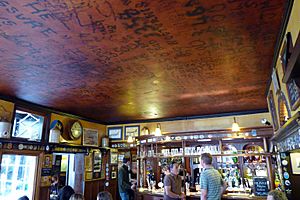The Eagle, Cambridge facts for kids
Quick facts for kids The Eagle |
|
|---|---|

The Bene't Street frontage looking west
|
|
| General information | |
| Location | Bene't Street |
| Town or city | Cambridge |
| Country | England |
| Coordinates | 52°12′14″N 0°07′06″E / 52.204°N 0.1182°E |
| Completed | 1667 |
The Eagle pub in Cambridge, England, is a very old building. It opened way back in 1667! It used to be called the Eagle and Child. It's the second oldest pub in Cambridge.
The front part of the building, facing Bene't Street, is from around 1600. Behind it, there's a newer part from the 1800s with a cool courtyard. Corpus Christi College owns the land. A company called Greene King runs the pub.
A Look Back in Time
World War II Airmen's Messages
During World War II, many brave RAF airmen and other Allied pilots visited The Eagle. They used wax candles, lighters, and even lipstick to write their names and squadron numbers on the ceiling. This special tradition is thought to have started with RAF Flight Sergeant P. E. Turner. He climbed onto a table one night to burn his squadron number onto the ceiling.
This ceiling, now called the "RAF Bar," was later cleaned and saved by James Chainey. He was a former RAF Chief Technician. He worked to uncover and protect these unique messages from the past.
The Discovery of DNA
The Eagle pub was a popular spot for scientists from the University of Cambridge. Their lab, the Cavendish Laboratory, was very close by. Because of this, The Eagle became famous for a huge science announcement.
On February 28, 1953, two scientists, Francis Crick and James Watson, were having lunch there. They had just figured out the amazing structure of DNA. DNA is like the instruction manual for all living things. Crick excitedly told everyone in the pub that they had "discovered the secret of life!"
This famous moment is written about in Watson's book, The Double Helix. You can see a special blue plaque outside the pub that remembers this event. Inside, there are two more plaques near the table where Crick and Watson often ate. Today, the pub even serves a special drink called "Eagle's DNA" to celebrate this discovery.
Also in 1953, Watson and Crick used their lunch breaks at The Eagle to make an important list. They listed the 20 main amino acids. These are the building blocks of proteins. This list helped scientists understand how DNA gives instructions for making proteins.




